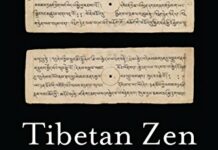
Ebook Info
- Published: 2011
- Number of pages: 324 pages
- Format: PDF
- File Size: 2.18 MB
- Authors: Sam van Schaik
Description
Situated north of the Himalayas, Tibet is famous for its unique culture and its controversial assimilation into modern China. Yet Tibet in the twenty-first century can only be properly understood in the context of its extraordinary history. Sam van Schaik brings the history of Tibet to life by telling the stories of the people involved, from the glory days of the Tibetan empire in the seventh century through to the present day. He explores the emergence of Tibetan Buddhism and the rise of the Dalai Lamas, Tibet’s entanglement in the “Great Game” in the early twentieth century, its submission to Chinese Communist rule in the 1950s, and the troubled times of recent decades. Tibet sheds light on the country’s complex relationship with China and explains often-misunderstood aspects of its culture, such as reborn lamas, monasteries and hermits, The Tibetan Book of the Dead, and the role of the Dalai Lama. Van Schaik works through the layers of history and myth to create a compelling narrative, one that offers readers a greater understanding of this important and controversial corner of the world.
User’s Reviews
Reviews from Amazon users which were colected at the time this book was published on the website:
⭐I read this book (and several on China) prior to taking a tour of China in June 2012 including a couple of days in Tibet. My rather minimal knowledge of Tibet had been limited to reading the endless Dalai Lama vs. China news stories of the last half century. As noted by reviewer O’Brien, this is a clearly written history and Van Schaik has no political axe to grind.The history of conflict between the Chinese and Tibetans goes back to the 7th century and has continued on and off ever since. There has also been violent conflict within Tibetan society during their history usually involving Buddhist sects. This can be a little surprising if one has heard nothing but how Buddhism is devoted to finding interior peace. However it is not that much different from Western history – religion, politics and human nature frequently lead to war and intolerance.My brief time in Lhasa revealed a tense atmosphere and a country undergoing changes – cultural changes forced on them by the Chinese as well as the influence of the modern world. The local tour guide admitted he had to be careful with his statements to us. He did say that tourism, a growing source of income in the area, was much more limited in 2012 than in 2011. This was apparently due to recent “self-immolations” by Tibetan Buddhist monks. The Chinese government limits outside visitors when Tibetan protests are in progress. The military and police, who were prominent throughout China, were more heavily armed in Lhasa.This is a time of continuing change and conflict in Tibet. The same is true within China and between China and all of its neighbor countries. It is helpful to us on the outside to have an understanding of the history of both China and Tibet. This book is an excellent contribution to that understanding.
⭐I have enjoyed Sam van Schaik’s translations of important Tibetan Buddhist texts and after reading his latest (
⭐) and really enjoying its historic and archeological flavor discovered this book. I have also read several other history books on Tibet over the past 4 decades but find this one the most enjoyable and informative, sympathetic but also psychologically and historically perceptive.Van Schaik takes a narrative approach to weave an engrossing, balanced and fascinating tale of this unique culture’s complex history. Too often in popular culture (both political and religious) Tibet gets painted with broad and romantic brush strokes. The actual story told here is much more human and interesting…Ps. If you are really interested in getting a firm and broad grasp of Tibet’s history I strong recommend getting a copy of A Historical Atlas of Tibet by Karl Ryavec to have as a reference and supplement when reading van Schaik’s book.
⭐A thorough review of Tibet. I bought it to find out about the images on my Tibetan chest and ended reading every word. In some mystic way Tibet is now a country of the heart
⭐I recommend this due to it’s clarity and non biased view of the history of Tibet and it’s relationship with the nations on its borders. It is strong, clearly written and a gripping tale.
⭐Excellent book, clearly written, jargon-free. Vast historical perspective of Tibet’s conflict-ridden formation. Analysis underlines the historical formation of common practices, values, institutions, traditions, historical stories, identities, etc. among Tibetans, along with the production of differences and hierarchies among themselves and others –i.e., always in relation with different groups from both neighbouring and distant lands. No reification, no romantic essentialist perspective, but complex, relational, conflicting and cohesive historical processes. Fantastic contribution to our understanding of the ongoing historical formation of peoples and their conflicting claims of unity, common territories, identities, etc. No good/evil, indigenous/foreign dichotomies taken for granted, but critically analysed. Hence, radical partisans of China-centred or idyllic-Tibet-centred perspectives are going to be challenged. Enjoy it.
⭐Provides very useful historical context for anyone interested in Tibetan Buddhism and the broader region – the interwoven notes in major Buddhist figures and their works is particular helpful.
⭐This is a complex and often misunderstood story. Misunderstood because of the simplification that writers often resort to when the going gets tough and complicated. Sam van Schaik has made the research for my own book, High Hopes, the history of Tibetan education in india, 1959-2015 much more interesting and he has made clear, issues which others had either skimmed through or avoided. I thank him for that. A very interesting read making one feel much better informed.
⭐this book is quite extensive and walks you thru over a thousand years of Tibet history. You get a good feel as to why Tibet is in its present predicament. Didn’t read like a history book. It was more like reading several short stories. I recommend this book to anyone who wants to understand how Tibet’s culture and History is unique to its people and anyone claiming otherwise is propagating false information.
⭐An honest introduction to the history of Tibet that doesn’t spare anybody’s feelings. The Chinese historical claim to the territory of Tibet is utterly thrashed as is the view that Tibet was a peaceful Shangri-La until the modern world shattered its spiritual bubble. The widely held view that Bon Religion predates Tibetan Buddhism is also upended. Starting from the seventh century, when god-kings curried favour from disparate local Chieftans and foreign forces, we journey the centuries when Buddhism both flourished and withered in cycles due to not only anti-Buddhist forces but principally due to in fighting, intrigue and power lust among the principle monastic abbots, Tulkus, as well as successive Dalai and Panchen Lama’s.. In more recent history the effects of international trade, colonialism, globalism and the power struggle between Russia, China, and Britain are examined. This book comes highly recommended to the general reader but also for practitioners of Tibetan Buddhism who will acquire a more grounded and sturdy view of their philosophical tradition in place of the misty eyed gaze of a ‘dharma-bum’ It is the perfect introduction to Tibets history and will sit comfortably alongside the esoteric histories of the region more often pandered to in the west.
⭐Very well presented history of Tibet from the 7th century onwards. Clearly well researched and giving an insight into the development of Buddhism and Bön in the region known as Tibet and how their often uneasy relationship with temporal power ebbed and flowed over time. Useful from both a historical perspective and from a practicing Buddhist perspective. Counting myself as one of the latter, the context this book provides gave insight into the development of various practices and lineages and the role of key personalities. It strikes a reasonable balance between demystifying and allowing the mystical. I found it compelling.
⭐A concise introduction to Tibetan history, which is fascinating and exciting. Moreover, the author has managed to pull of the almost impossible feat of while giving an excellent account of Sino-Tibetan relations through the ages, is written so unbiasedly that he can hardly offend either side (or perhaps both equally). A must-have for anyone interested in (obviously) Tibetan history but also for anyone who wants an understanding of how the situation as regards Chinese rule in Tibet is as it is at present.
⭐I am not a talented reviewer and this is the first time I have submitted a review to Amazon. Following a trip to the Sherpa region of Nepal a few years back I became very interested in their Buddhist culture which had spread down to them from Tibet (Mahayana branch). I wanted to understand Tibet a little better and this book has done so exceeding all my expectations. With apologies to the author it reads like a “can’t put down” page-turning novel as the history of this fascinating country unravels. As an outsider to Tibet one has to wonder whether its magic and mystery could have survived for too long in this internet world even without the invasion of the PRC. Something has undoubtedly been lost, no maliciously destroyed, and we are no better for it. Mr Van Schaik has done an excellent job – well recommended.
⭐An excellent political history – simple to read, straight forward, un-biased and direct. The only fault I fin with the book is that it could have been longer – to include more detail. The final part of the is based a little too much on the Dalai Lamas at the expense of the many other aspects of Tibet in the 19th and 20 Centuries.
Keywords
Free Download Tibet: A History in PDF format
Tibet: A History PDF Free Download
Download Tibet: A History 2011 PDF Free
Tibet: A History 2011 PDF Free Download
Download Tibet: A History PDF
Free Download Ebook Tibet: A History

